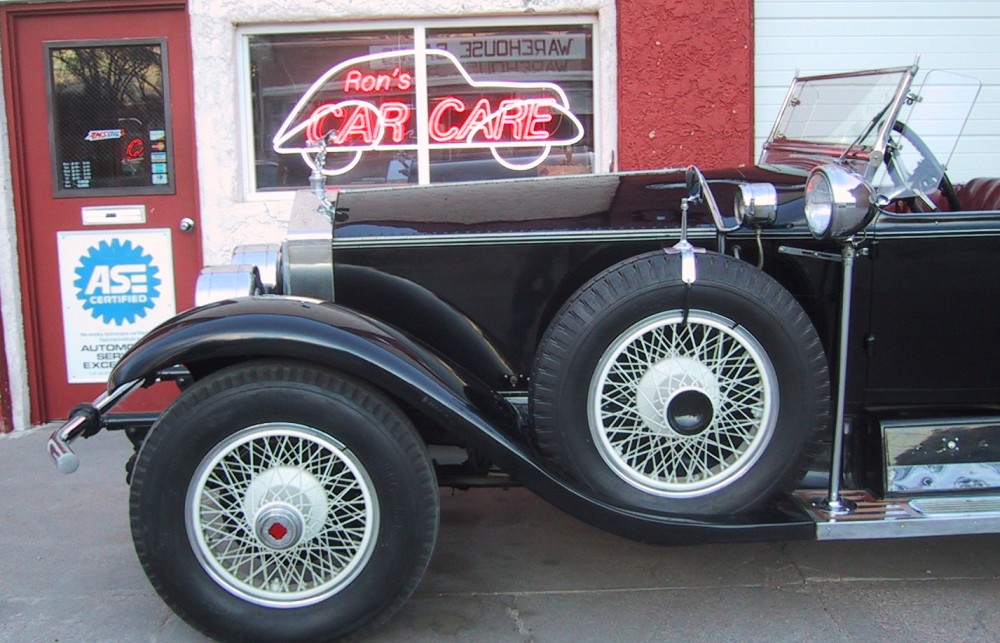Mechanics as Hackers
from Hemmings Motor News
December, 2012 – Daniel Strohl
There’s a joy in taking things apart.
Too much of our mechanical and electrical world operates out of sight and out of mind from our everyday lives. It churns along behind blank panels and under aesthetically neutral covers, ticking away, shuttling electrons, revealing little of what it does until the day things go awry, typically leaving us befuddled as to why.
Getting under those covers, whether before or after that kerblooie moment, may sometimes feel illicit–especially when the thing you’re trying to take apart is held together with security screws–but it helps empower us, the consumers, by allowing us to better understand how these things work and by allowing us to repair and modify them as necessary, rather than replace them whenever they fail.
To anybody who’s ever owned an old car, I’m just stating the obvious here. Cars have hoods for a reason. We’d never send a car to the junkyard just because the starter failed. And that makes us hackers.
Now, understand that the term “hacker” has been used incorrectly by popular culture and the media over the last couple of decades. It does not refer to criminals who break into computer systems with nefarious motives; rather, it refers to the inquisitive among us, the tinkerers and the mad scientists and the mechanics, those of us not content with simply accepting planned obsolescence or the off-the-shelf products forced on us by a consumption-oriented society.
More recently, the hacker subculture has found both a philosophical center and widespread acceptance as the Maker movement, embracing a diverse array of hobbies–electronics, crafts, woodworking, robotics, you name it–in an effort to get regular people working with their hands and minds to invent and create things. And there’s plenty that we automotive hobbyists can learn from the Maker movement.
First off, the Maker movement is a very egalitarian and (little-d) democratic one, so it not only celebrates the amateur (which is a good thing–see “Sound of Speed,” HMN November 2011), but it also embraces open-source thinking: sharing solutions to problems that would normally hinder beginners from getting involved.
One development that has grown out of this philosophy is the hackerspace, a physical place where Makers can gather to share ideas, to pool resources, to work on their personal projects using tools that belong to the hackerspace (who wouldn’t love access to a waterjet cutter or a CNC machine?), and, most importantly, to join a community of like-minded enthusiasts. A company called TechShop has actually built a number of these spaces already, any of which would be well suited to car guys working on custom projects, and military members and veterans are no doubt familiar with the on-base hobby shops they could use for repairing their cars. An enterprising gearhead would do well to establish a hackerspace for car guys, either for profit or simply for the communal aspect.
The Maker movement has also introduced a market for 3D printers, which once cost six figures and were used primarily by manufacturers for rapid prototyping. Now, with hobbyist models hitting the marketplace for as little as $1,000 to $1,500, some old-car enthusiasts are pointing out how well suited 3D printers (particularly when paired with 3D scanners) are for replicating obsolete parts necessary to get old cars back on the road again. For the past three years, Jay Leno has been experimenting with 3D printers and scanners for just that purpose, and we’re hearing of high-end restoration shops looking into the technology. It won’t replace, say, a forged piston, but the technology is surprisingly capable.
Of course, it takes some familiarity with CAD and mechanical processes to get the most out of 3D printing, and the Maker movement has done a good job promoting technological literacy, inspiring budding Makers to take up CAD, welding, computer programming, acid etching and a thousand other skills. It wouldn’t hurt us old-car guys to add to our repertoires as the Makers so nimbly do.
Most importantly, though, the Maker movement–perfectly encapsulated by the slogan “If you can’t open it, you don’t really own it”–shows us that it’s not at all illicit to reconnect with the devices and the automobiles that we live with, that it’s okay to open them up, take them apart, and get to understand them a little better.
This article originally appeared in the December, 2012 issue of Hemmings Motor News.

I totally agree. When I look at something and determine it wasnât born that way, it must be disassembled. If it was glued together or welded, thatâs what knives, screwdrivers and angle grinders were made for. Even if it was born that way, an angle grinder can make a pretty good slicer so you can see if it is the same all the way throughâ¦
WTFâ¦. If it canât be reassembled or made to work, thereâs probably another one just like it in the junk yardâ¦. Remember, third try is the charm.
2012-12-04 AB BusCard – Outlook Signature.jpg
******************************************* CONFIDENTIALITY NOTICE Information contained in this e-mail transmission is privileged and confidential. If you are not the intended recipient, do not read, distribute, or reproduce this transmission. If you have received this e-mail transmission in error, please notify us immediately of the error by return email and please delete the message from your system. Thank you in advance for your cooperation. *******************************************